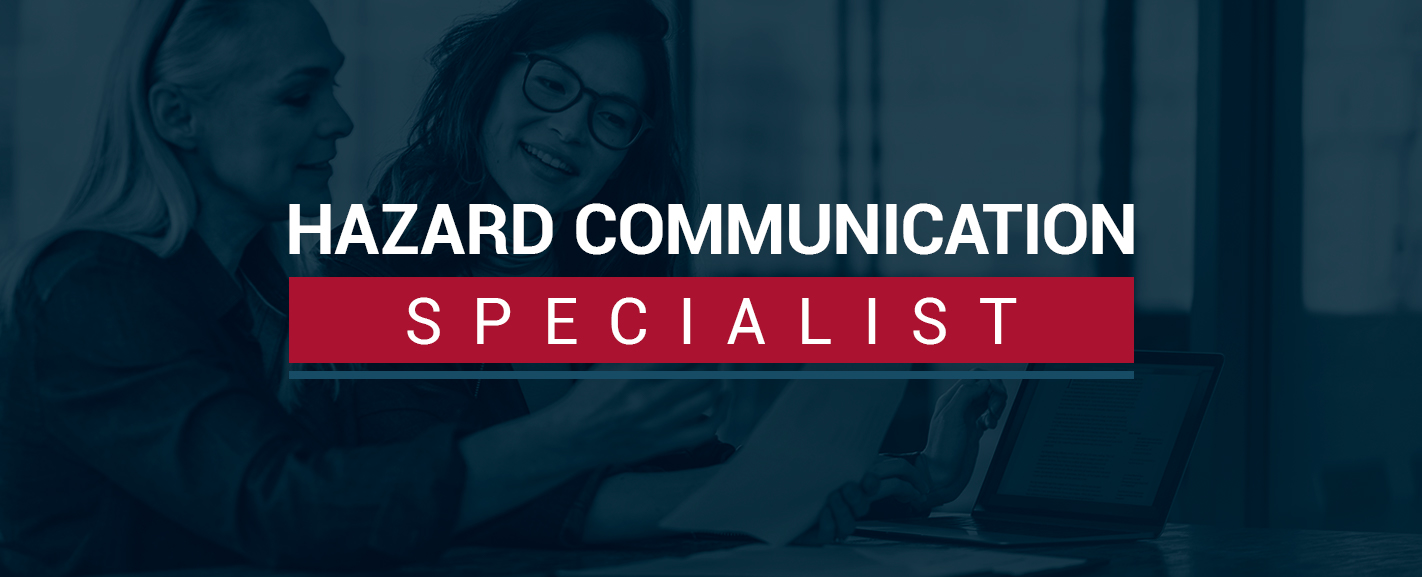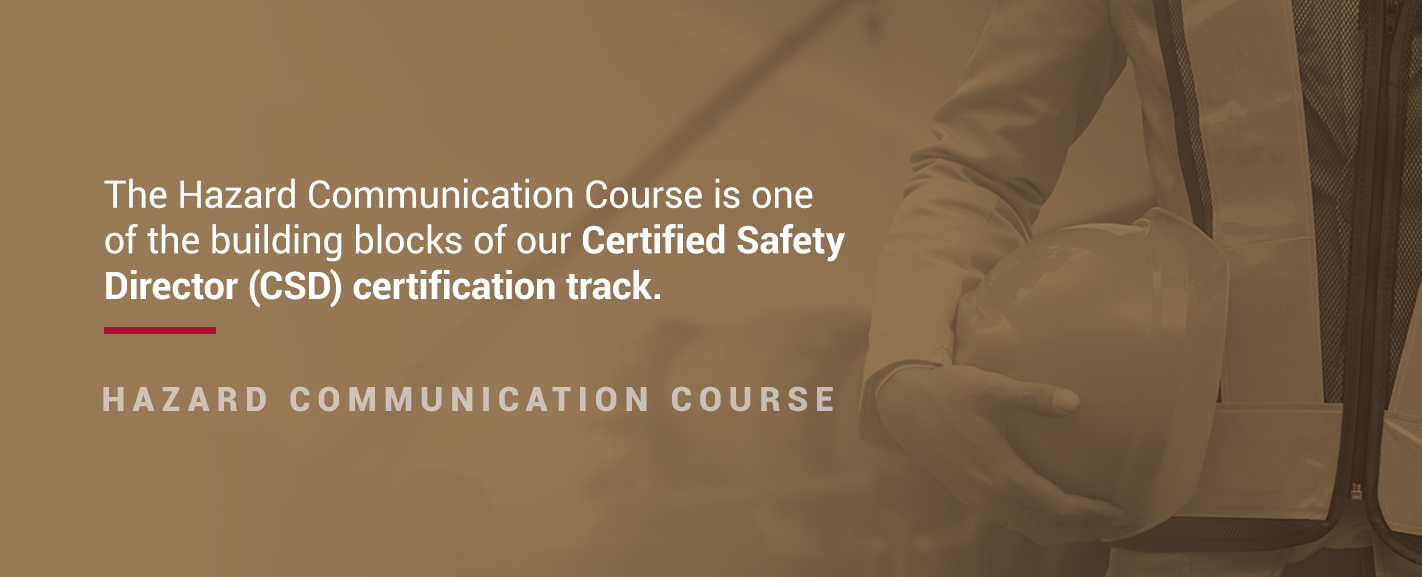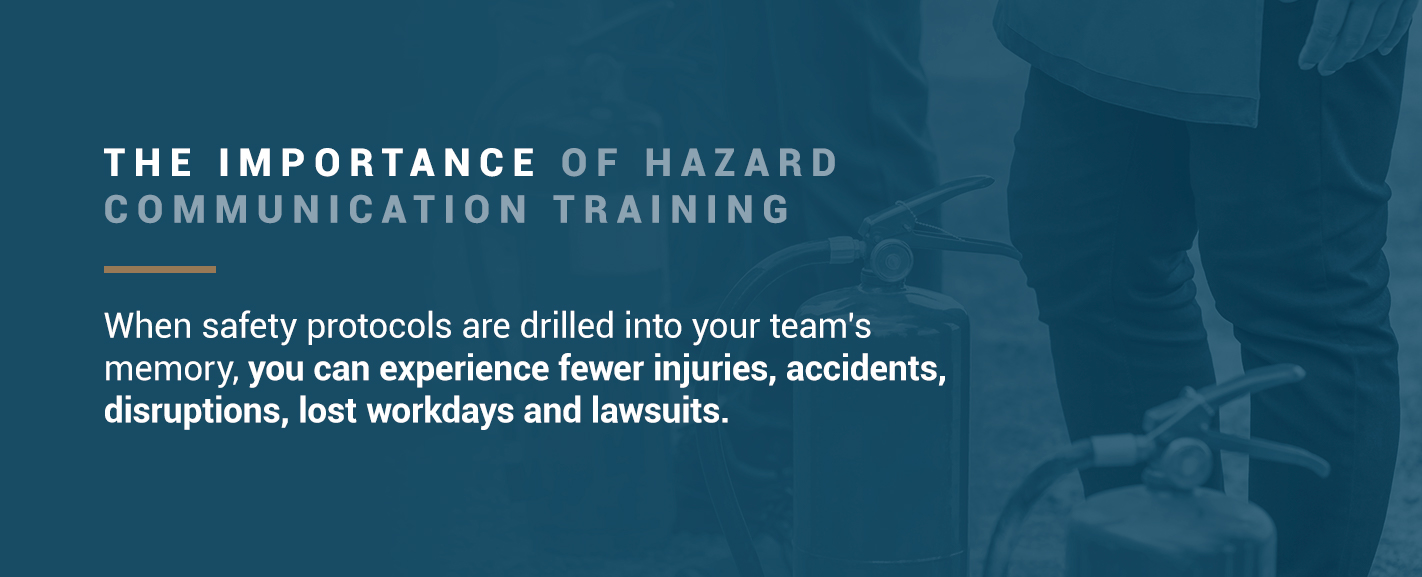Hazard Communication Specialist Course

Jump To:
- What Our Hazard Communication Specialist Covers
- Hazard Communication Course Objectives
- OSHA Hazard Communication Standards
- The Importance of Hazard Communication Training
- Hazard Communication Specialist (HCS) Course
OSHA issued 3,624 hazard communication standard citations in FY 2019, costing American companies $4,682,380. Over 43 million workers are exposed to hazardous chemicals at work, and they have the right to know what those chemicals are and their dangers. To prevent your workplace from violations and injury lawsuits, you must understand the many nuances of OSHA’s standard. To get yourself up to speed, consider getting certified as a Hazard Communication Specialist (HCS). The National Association of Safety Professionals (NASP) offers extensive HCS training for safety professionals like you.
What Our Hazard Communication Specialist Covers
You can complete our Hazard Communication Specialist Certificate course in about 13 hours, depending on your baseline knowledge of workplace safety. It takes a deep dive into OSHA’s hazard communication standard, 29 CFR 1910.1200. This rule was updated in 2012 to align with the Globally Harmonized System of Classification and Labeling of Chemicals (GHS) and other factors. Our course covers all the new information you need to know, including:
- Globally Harmonized System overview:Our course discusses why OSHA adopted GHS and compares HAZCOM 1994 requirements to the new version.
- Labeling hazardous chemicals:It’s critical to understand the GHS labeling and pictogram requirements. You’ll also discover what chemicals need labeling and how to label them correctly.
- GHS pictogram assessments: Your employees must be able to recognize the GHS pictograms. To stay compliant, you must reassess your employees’ memory every so often. Learn how to put their knowledge to the test.
- Safety Data Sheet (SDS) formatting: OSHA requires chemical SDSs to have a uniform 16-section format. Learn how to read these sheets and verify the compliance of distributed SDSs.
- Changes to the physical and health hazard classifications: Get up to date on the classifications you need to communicate and train your workers on.
- Developing a hazard communication program: OSHA requires employers to maintain a hazard communication program. The plan must include appropriate labeling, SDSs and training for workers. It must be documented and periodically reassessed. You’ll learn the steps involved in creating a comprehensive program that meets or exceeds OSHA standards.
- Training employees: Training is essential to hazard communication. Employees need to understand chemical terms, labels and SDS formatting and be able to recognize pictograms. Knowing what to do when incidents occur should be second nature. Learn adult education techniques to help information stick and ensure your training covers or exceeds all requirements.
Hazard Communication Specialist Training Course
Hazard Communication Course Objectives
After completing the hazard communication course and passing the exam, you’ll gain:
- A comprehensive understanding of OSHA’s 2012 HAZCOM standard.
- The knowledge, skills and resources for complying with 29 CFR 1910.1200 and going beyond it to create a safer workplace through HAZCOM.
- The qualifications, knowledge, training materials and techniques for providing engaging HAZCOM instruction.
The Hazard Communication Course is also one of the building blocks of our Safety Director Certificate (SDC) track. This comprehensive course covers 11 areas of specialization, including the HCS designation. As a SDC, you can develop a company-wide safety program and become an authorized instructor for many NASP training courses. Completing the HCS course can help you pave the way to this exciting career milestone.
With a valid HCS Certificate under your belt, you can shorten the study hours required for your SDC. You can also qualify for special pricing by contacting us.
OSHA Hazard Communication Standards
The original hazard communication standard earned the nickname “right to know.” It sought to make employees aware of the chemicals in their workplace and what precautions to take around them. The 2012 update to 29 CFR 1910.1200 improves this standard by establishing employees’ right to understand the chemicals in their work environment.
The standard applies to all chemical manufacturers, importers and distributors. They must evaluate the hazards of the chemicals they produce, ship or sell, and create labels and SDSs conveying the relevant dangers to customers. It also applies to all employers whose workplaces contain hazardous chemicals. Employers must provide SDSs and labels and train exposed workers on how to handle the chemicals safely. The four major changes to the hazard communication standard include:
- Hazard classification: The standard specifies new criteria for classifying the health and physical hazards associated with different chemicals and mixtures.
- Labels: The GHS labeling system dictates manufacturers and importers include a harmonized signal word, pictogram and hazard statement for each class and category of risk. They must also include precautionary statements.
- Safety Data Sheets: SDSs now need a uniform format. The 16 sections identify the product, manufacturer, associated hazards and composition. They will also address all appropriate first-aid, fire-fighting and accidental release measures. Other information included lists handling and storage information, controls and personal protection measures, physical and chemical properties, stability and reactivity lists and toxicological data.
- Information and training: Any employees exposed to hazardous chemicals need training on labels and SDS formatting. Employers should ensure recognition and comprehension.
Our Hazard Communication Specialist training covers the OSHA standard in-depth, including the elements that have carried over from previous versions. Through our unique multimedia approach delivered in plain English, we’ll help you understand all the regulations that apply to your workplace.
Purchase Hazard Communication Specialist (HCS) Course
The Importance of Hazard Communication Training
Hazard communication training is equally essential for employees and the safety instructor. First, employers are obligated under subsection (h) of the standard to provide training to relevant employees. Presenting this information in an engaging way that goes beyond OSHA requirements can prevent more injuries, saving the company money. Further, OSHA’s second-most-frequent citation (and first in general industry) is for violations of the hazard communication standard. It pays to make the training as comprehensive as possible, which is why ensuring your instructors are trained and certified is crucial.
If you’re a safety professional, providing employee training may fall on you. Adequate hazard communication training for employees must go beyond chemical data sheets. OSHA expects workers to learn the hazards of the chemical present in their work area and how to protect themselves. There must be opportunities for students to ask questions, and the learning must be easily understood. This information can save lives. When safety protocols are drilled into your team’s memory, you can experience fewer injuries, accidents, disruptions, lost workdays and lawsuits.
Because this training is an OSHA requirement, you’ll need to document the time, place and content of your training sessions. You’ll also need records of employee attendance. At NASP, we make training your employees simple with our basic training in hazard communication for employees. Employees can take the training online and gather to ask questions and discuss polices specific to your workplace. Employees will earn certificates of completion, making record-keeping simple.
If you’re conducting the training yourself, we recommend Hazard Communication Specialist Course. Our coursework for safety professionals covers how to effectively train your employees in HAZCOM rules in an attention-holding and memorable way. You’ll also gain credibility as a trainer by earning a certificate. As a qualified HAZCOM trainer, you can offer your employers value by allowing them to keep this valuable learning in-house. When you onboard new employees or when employees miss training days, you can run sessions on your schedule.
Purchase Our Hazard Communication Specialist (HCS) Course
Become a Hazard Communication Specialist and learn everything there is to know about the hazard communication OSHA standard. We speak your language — no legalese or jargon — so you can quickly grasp what you need to know to get your workplace compliant. Our training for safety specialists is stimulating, interactive and geared for knowledge retention. Add real value to your workplace through your advanced safety skills and knowledge.
Sign up for our Hazard Communication Specialist training to jump-start your career and create a safer workplace for everyone.
Related Posts






